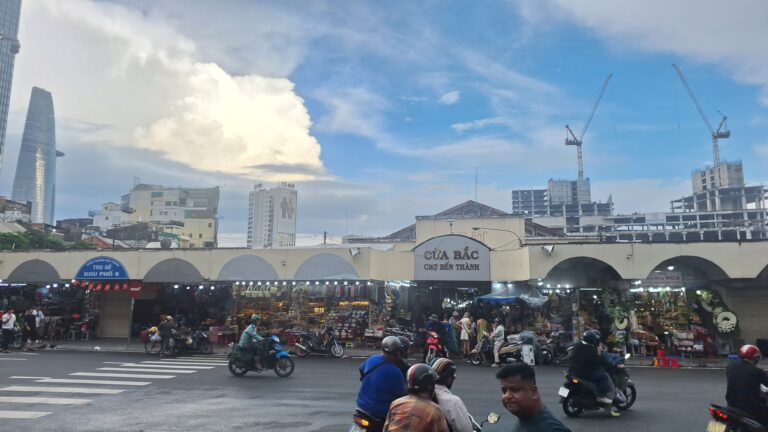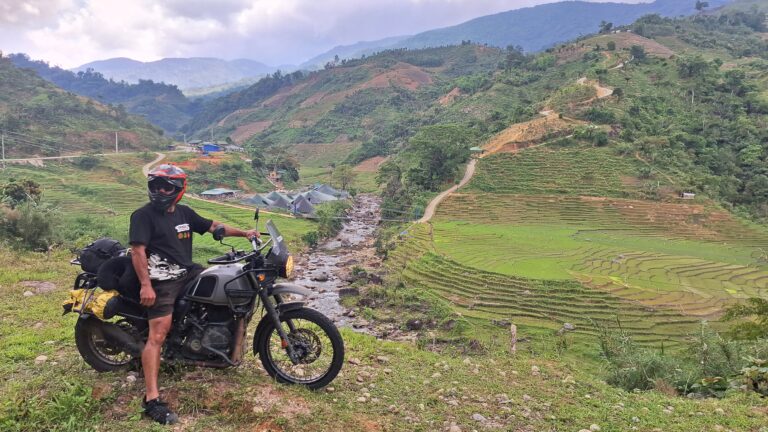
Best Street Food in Vietnam
Share:
- Published:
- Updated: 19/02/25

A motorcycle rider needs food like his bike needs fuel. Unlike bikes, however, we humans need variety to keep us in high spirits. That’s one of the reasons Vietnam is so popular with adventure riders: The food is just as much of an adventure as the riding itself.
Vietnamese food has gained worldwide popularity in recent decades. However, many dishes remain to be discovered by much of the outside world — or even different parts of Vietnam. The country can be split into three culinary regions, each with its own unique street food. If you’re curious to sample a variety of street-side bites while on a trip, you’re in the right place.
Let’s take a look at the best street food in Vietnam, and then take a trip from north to south exploring items that would make for a good highlight reel.
Table of Contents
The Best Street Food in Vietnam - Nationwide
Many dishes in the following region-wide lists can be found across the country. However, a few specific favorites are universal in Vietnam as well as universally appreciated by street food enthusiasts. Let’s take a look at some of the most popular and common items before getting more specific.
Bánh Mì

The internationally popular Vietnamese sandwich comes in many varieties and can be found everywhere. Most often they’ll be served from small carts on the side of the road, especially near markets. Additionally, specific brands like the nationwide Ba Hung bakery will have larger establishments, as well as locally popular brands like Hoi An’s Bánh Mì Phuong or Madame Khanh.
Ingredients vary. Options include:
Chả (pork bologna)
Op La (fried egg)
Thịt Nướng (grilled pork)
Pâté (pork paté)
Xíu Mại (meatballs)
Chay (vegetarian, usually with mock meat)
Thịt Nguội (ham)
Chả Bông (pork floss)
If you order simply a “Bánh mì” at a stall, you’ll most likely get a “Bánh mì thịt,” where “thịt” literally means “meat” but is synonymous with pork. In some cases this could mean mystery meat, or it could mean grilled pork. Look behind the glass at the cart to see what you’re getting.
Condiments usually include margarine, chili sauce, pickled carrots and papaya, cucumber, and coriander (cilantro).
Phở

Phở is a nationwide phenomenon in Vietnam, and the country’s national dish. However, diners will find that a number of different varieties exist in the country, and they’re usually delineated by origin. Hanoi style-phở, for example, is a simple and straightforward affair. Consisting of phở noodles (for which the soup gets its name), beef or chicken, a savory stock, bean sprouts, sliced onions, scallions, and a plate of herbs, its main focus is the broth. Condiments include lime, pickled garlic, chili sauce, and fish sauce.
Southern-style phở is a more extravagant affair, often with a sweeter broth, a larger plate of herbs, and even larger serving sizes.
Generally speaking, you can put phở on a sliding scale, and different restaurants somewhere between northern and southern extremes. In the north, phở is more commonly eaten for breakfast, whereas it’s often an all-day meal in the south.
To simplify things as much as possible, however, there are generally two varieties:
Phở bò (beef pho), with options including:
Tái (rare thinly sliced beef cooked in broth)
Bò viên (beef meatballs)
Gầu (fatty brisket)
Nạm (beef flank)
Gân (tendon)
Đặc biệt (special, with a bit of everything)
If you don’t know what to order, phở bò tái is often the most popular choice.
Phở gà (chicken pho) which usually comes in just one variety.
Hủ tiếu

Hủ tiếu
Hủ tiếu is a popular Cambodian-style soup with thin rice noodles, a flavorful broth made with both pork and chicken stock, and a variety of aromatics. A popular variety is Hủ tiếu “Nam Vang,” which refers to the Vietnamese name for Phnom Penh and indicates the soup’s origins. Due to both its unique broth and chewy noodles, hủ tiếu differs from pho significantly in taste and appearance, and comes with different options. These often include:
Bò tái (rare thinly sliced beef cooked in broth)
Xương (a meaty stewed pork joint)
Trứng cút (boiled quail eggs)
Lòng heo (pork intestines)
Tôm (poached shrimp)
Mỡ heo (pork crackling)
Each hủ tiếu shop or stall will have its own offerings, so take a look at what’s on offer and, if you’re lost for ideas, point.
North
Northern Vietnamese cuisine, centered around Hanoi, is known for its subtlety, balance, and focus on the natural flavors of the ingredients. Dishes tend to be less sweet than those in the south, with a preference for lighter and more delicate flavors. Noodle soups, herbs and spices, and grilled foods are very common.
Sample motorcycle adventure tours:
Sapa and Ha Giang Adventure
Hanoi to Hoi An: Phong Nha Caves Adventure
Bún Chả

Grilled pork (chả) is served with rice vermicelli noodles (bún), sweet pickled papaya, fresh herbs, and a tangy, sweet, and slightly fishy sauce. This is one of the most popular dishes in the country, and for good reason. The two types of pork it’s usually served with (pork belly and minced pork patties) are charcoal grilled and slightly charred to give a deliciously smoky flavor that perfectly enhances the salty, sweet, and spicy sauce. U.S. President Obama made a small Hanoi eatery internationally famous when he stopped for the dish there.
Bánh Cuốn

Often called Vietnamese rice rolls, these are made from a thin, wide sheet of steamed fermented rice batter. They’re filled with minced pork, wood ear mushrooms, and often onions. They’re served with a side of sweet and salty dipping sauce (nước chấm)
Bánh Gối
Literally meaning “pillow cake,” these are deep-fried dumplings filled with a mixture of ground pork, mushrooms, and occasionally glass noodles. They’re crispy on the outside and soft inside, and often served with a sweet and tangy dipping sauce
Gỏi Cuốn

These internationally-famous fresh spring rolls are wrapped in translucent rice paper with shrimp, pork, vermicelli, lettuce, and herbs. They’re light, refreshing, and often dipped in a peanut sauce. The balance of flavors and textures makes these a popular item, especially in the warm months.
Nem Rán or Chả Giò

Classic deep-fried spring rolls. These crispy perennial favorites are filled with a combination of pork, crab, mushrooms, glass noodles, and vegetables, and served with lettuce and herbs to wrap as well as a tangy dipping sauce. Chả giò are frequently added to fresh bún noodles, though more common in the south.
Xôi
Sticky rice is served in a variety of forms, often sweet with toppings like mung bean or savory with pork floss, grilled pork, or chicken.
Central
Central Vietnam is where Onyabike Adventures calls home. The region is home to some unique food, often with a spicy profile compared to much of the rest of the country. Due to its closeness to the sea, seafood is a very common element of central Vietnamese cuisine. If you’re with us on any of our Central Vietnam tours, we’ll make sure you get the best of the best. Visitors are often surprised at how different the food can be between short distances — each town has its own thing going on.
Sample motorcycle adventure tours:
Hue, Hai Van Pass, and the Ho Chi Minh Trail
Hill Tribes and Mountain Rides
Explore Central Vietnam
Bánh Canh

Bánh canh is a thick noodle soup with slippery, chewy noodles that give it a unique mouthfeel. It’s popular in Da Nang and Quảng Nam province as well as much of the rest of central Vietnam. The broth is often seafood-based, with crab, shrimp, pork, or fish cakes making popular fillings. Frequently, it’s served with savory fried dough sticks which make for excellent dipping.
Mì Quảng

Hailing from Quảng Nam province, this dish is one of the most popular noodle dishes in the region. The noodles are thick and yellow, served in a shallow bowl with a small amount of turmeric-infused broth. It’s topped with pork, shrimp, quail eggs, and fresh herbs, and then topped with peanuts, rice crackers, and more herbs. A chicken version with a stewed chicken leg is also popular. It’s perfect for hot days as it’s usually served room temperature.
Bún Bò Huế


Originating from Huế, this spicy noodle soup has become one of the most popular dishes in the country. It’s known for its distinctive red chili oil and lemongrass-flavored broth. It includes sliced beef, beef shank, pig’s blood cake, and lots of herbs. It’s among the spiciest and most sour of Vietnamese noodle soups, making it unique and much-loved by its adherents. Noodles are thin rice vermicelli noodles.
Nem Lụi

Nem lụi are skewers of lemongrass-marinated minced pork, grilled over charcoal. They’re most often served wrapped in rice paper with fresh herbs and a peanut dipping sauce. These are street food favorites in Da Nang and Hoi An, often accompanied by bánh xèo and thịt nướng (grilled pork). These crowd pleasers pair extremely well with cold local beer and are excellent group-dining food.
Cơm Hến / Bún Hến

Bánh Bèo

These are small, steamed rice cakes topped with savory ingredients like shrimp, dried shrimp, or pork floss. They’re served with a notable sweet and spicy fish sauce. While these are most popular in Huế, they’re popular throughout the region and make for fun munching as they’re bite-sized.
Bánh Ướt Thịt Nướng

These are similar to the popular fresh rice paper rolls known internationally, but they’re more specific to Da Nang and the surrounding area. These are fresh, moist rice sheets (the name literally means wet cake) served with grilled pork, herbs, and a sweet, tangy dipping sauce
Chả Huế
This Huế-style sausage is known for its balanced flavors, including pork, wood ear mushrooms, and spices. It’s served with bánh ướt or eaten with rice.
South
Southern Vietnam, with Saigon as its culinary hub, is known for its bold flavors, liberal use of herbs, and a noticeable sweetness in many dishes. Sweet is often balanced with savory elements like fish sauce. A wide variety of influences, including Chinese, Khmer, and French flavors have made their way into southern-style cuisine.
Sample motorcycle adventure tours:
The Full Monty: All of Vietnam
Cơm Tấm

A nationwide favorite but especially popular in the south, cơm tấm literally means “broken rice.” The rice is indeed broken into small grains—which in past times was a cheaper form of rice purchased to save money. These days, cơm tấm is all about what it’s served with. The most popular serving is with a grilled pork chop, shredded pork skin, a fried egg, and various pickled vegetables.
Many other options are available at shops, including stuffed tofu, omelettes, sautéed green vegetables, or grilled fish. If you see a display case, you can simply point at what you want. It’s almost universally served with a sweet and tangy fish sauce that pairs perfectly with savory flavors.
This dish is widespread in Saigon, frequently enjoyed for lunch. It’s known for its comforting, home-cooked feel despite being street food.
Bún Thịt Nướng

Bún Thịt Nướng consists of grilled pork (thịt nướng) served over cold vermicelli noodles (bún). The pork is often marinated with lemongrass, garlic, shallots, fish sauce, and sugar or honey to give a sweet-savory flavor. The dish comes with a variety of fresh herbs like mint, basil, and cilantro, as well as sliced cucumber, pickled carrots and daikon, crushed peanuts, and fried scallions.
In the south, it’s typically served with a sweet and salty fish sauce. The central version, though less common, is served with peanut sauce.
A variety of the dish includes fried spring rolls (chả giò), which can replace the pork or be added to it. If you find a good one of these, you’re likely to return again and again.
Bánh Xèo

Bánh Xèo are popular nationwide, but are especially popular in the south. These are crispy Vietnamese pancakes made from rice flour, turmeric, and coconut milk. They’re filled with pork, shrimp, and bean sprouts. The “xèo” is an onomatopeia representing the sound the pancake batter makes when it hits the hot oil in a pan. These crispy pancakes are served with a variety of vegetables and dipped in fish sauce in the south or peanut sauce in the central region.
Bánh Khọt

These are miniature, crispy pancakes filled with shrimp. They’re served with a side of greens and fish sauce for dipping. Bite-sized and perfect for snacking, these little treats make for a good road-side stop for an appetizer and work perfectly as beer snacks.
Ốc (snails)

Bún Mắm
A flavorful, pungent noodle soup with fish, fermented shrimp paste, and a variety of meats and seafood topped with fresh herbs. It’s best known for its strong, distinctive taste due to mắm tôm — the fermented shrimp paste. Often a controversial item among westerners, mắm tôm is popular across Vietnam but is especially notable in the south. It’s made by fermenting tiny shrimp with salt for several weeks or months, producing a thick, dark paste with a strong flavor…and an unmistakable smell. For many, it’s an acquired taste. (Writer’s note: This is banned in my kitchen).
Bò Bía
Bò bía is a southern Vietnamese take on Popiah, a southern Chinese fresh spring roll. These are wrapped in soft rice paper with Chinese sausage, jicama, carrot, and egg, and served with a tangy, sweet hoisin sauce. These are especially common and popular in the Chinese-influenced areas of Saigon like District 5, where they’re found on many street corners and around parks.
Streetwise Street Food
As the saying goes, “discretion is the better part of valor.” Street food hygiene is a question many visitors have in Vietnam. When choosing a street food venue, pay attention to what the locals are doing. If a place is full of locals, that’s an excellent sign — it means they’re well-known in their location and have served countless people without issue.
When you’re on tour with us, you’ll have all the street smarts you need on your side. Our experienced guides know all the ins and outs of local food and will be able to present plenty of items to you that may not even be known outside of a small hamlet or back alley.
If you’re feeling adventurous and want to see what experiencing Vietnam on two wheels is all about, send us a message.
Recent Posts






